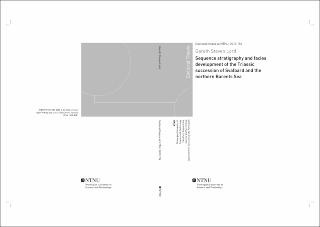| dc.contributor.advisor | Mørk, Atle | |
| dc.contributor.advisor | Olaussen, Snorre | |
| dc.contributor.author | Lord, Gareth Steven | |
| dc.date.accessioned | 2017-07-03T08:44:13Z | |
| dc.date.available | 2017-07-03T08:44:13Z | |
| dc.date.issued | 2017 | |
| dc.identifier.isbn | 978-82-326-2464-5 | |
| dc.identifier.issn | 1503-8181 | |
| dc.identifier.uri | http://hdl.handle.net/11250/2447576 | |
| dc.description.abstract | The Triassic succession of Svalbard is regarded as an analogue to the subsurface in the Barents Sea. In this thesis the sedimentology, facies development and sequence stratigraphy of the succession in Svalbard is addressed. The project has resulted in 4 journal articles, a submitted manuscript and a manuscript in preparation. A geological map has also been produced.
The project has created a new stratigraphic unit the Hopen Member, which is the south-eastern equivalent to the Isfjorden Member of Spitsbergen. This is based on the properties of the unit, its biostratigraphic and magnetostratigraphic characteristics. The Hopen Member is a succession of marine shale and subordinate sandstone deposits, different to the paralic deposits of the underlying part of the De Geerdalen Formation.
A study of channel bodies on Hopen shows they are confined to discrete stratigraphical intervals in the De Geerdalen Formation, defined as channel zones. Three zones are described and categorised as; a lower fluvial, middle tidal zone and upper fluvial zones. A paralic depositional environment for the De Geerdalen Formation on Hopen is maintained, however the nature of channels shows a greater influence of fluvial deposition, for the formation in this part of Svalbard. A multidisciplinary study of the Kapp Toscana Group (De Geerdalen, Flatsalen and Svenskøya formations) on Hopen is also presented and this provides an enhanced palaeo-environmental interpretation for the Upper Triassic succession on the island.
Upper Triassic deltaic sediments are seen throughout north-eastern Svalbard and analysis shows the De Geerdalen Formation to consist of three discrete informal units, defined by the gross depositional environment. The lower interval is dominated by shallow marine and delta front / shoreface deposits, the middle interval is composed of delta front to delta top deposits, and the upper interval is primarily delta top, lagoonal and lacustrine deposits. The De Geerdalen Formation represents a distal depositional setting in this area, in comparison to the depositional environments reported on the islands of Edgeøya and Hopen.
A facies study, conducted on the Svenskøya Formation in Eastern Svalbard, interprets the formation to be composed of sandstones deposited in a mixed fluvial, shoreface and shallow marine setting. Petrographic analysis of sandstones shows the formation as being arkosic, on Hopen and in the Sentralbanken area. The sandstone reservoir quality at Hopen is reduced compared to Sentralbanken, due to more extensive diagenetic impacts by compaction, mineral dissolution and extensive precipitation of pore-filling clay minerals. Similar properties are observed on Wilhelmøya and Kong Karls Land.
A regional study into the sequence development of the Triassic succession in Svalbard is the final component to this project. Analysis shows an increase in the number of low rank sequences in the western area of Svalbard, compared with central and eastern areas, in the Lower and Middle Triassic succession. This is due to the style of facies development, close to the basin margin at that time. The Upper Triassic shows the opposite trend, with an increase in low ranking sequences towards the east of Svalbard. Offshore the entire succession thickens as a result of deltaic development in these areas. | nb_NO |
| dc.language.iso | eng | nb_NO |
| dc.publisher | NTNU | nb_NO |
| dc.relation.ispartofseries | Doctoral theses at NTNU;2017:196 | |
| dc.relation.haspart | Paper 1: Lord, Gareth Steven; Solvi, Kristoffer H.; Ask, Marianne; Mørk, Atle; Hounslow, Mark W.; Paterson, Niall William. The Hopen Member: A new member of the Triassic De Geerdalen Formation, Svalbard. Norwegian Petroleum Directorate Bulletin 2014 (11) s. 81-96 | |
| dc.relation.haspart | Paper 2: Lord, Gareth Steven; Solvi, Kristoffer; Klausen, Tore Grane; Mørk, Atle. Triassic channel bodies on Hopen, Svalbard: Their facies, stratigraphic significance and spatial distribution. Norwegian Petroleum Directorate Bulletin 2014 ;Volum 11. s. 41-49 | |
| dc.relation.haspart | Paper 3: Paterson, Niall William; Mangerud, Gunn; Cetean, Claudia; Mørk, Atle; Lord, Gareth Steven; Klausen, Tore Grane; Mørkved, Pål Tore. A multidisciplinary biofacies characterisation of the Late Triassic (late Carnian-Rhaetian) Kapp Toscana Group on Hopen, Arctic Norway. Palaeogeography, Palaeoclimatology, Palaeoecology 2016 ;Volum 464. s. 16-42
Copyright © 2016 Elsevier. | |
| dc.relation.haspart | Paper 4: Lord, Gareth Steven; Johansen, Sondre Krogh; Støen, Simen Jenvin; Mørk, Atle. Facies development of the Upper Triassic succession on Barentsøya, Wilhelmøya and NE Spitsbergen, Svalbard. Norsk Geologisk Tidsskrift 2017 ;Volum 97.(1) s. 33-62. This work is licensed under a Creative Commons Attribution 4.0 International License. | |
| dc.relation.haspart | Paper 5: Lord, Gareth Steven; Mørk, Mai Britt Engeness; Mørk, Atle; Olaussen, Snorre. Sedimentology and petrography of the Svenskøya Formation on Hopen, Svalbard: an analogue to sandstone reservoirs in the Realgrunnen Subgroup. Polar Research 2019 ;Volum 38. s. - Open Access article distributed under the terms of the Creative Commons Attribution-NonCommercial 4.0 International License (http://creativecommons.org/licenses/by-nc/4.0/) | |
| dc.relation.haspart | Paper 6: Lord, Gareth Steven; Mørk, Atle; Høy, Tore. Sequence patterns in the triassic succession of svalbard and northern barents sea.
This paper is not yet published and is therefore not included. | |
| dc.title | Sequence stratigraphy and facies development of the Triassic succession of Svalbard and the northern Barents Sea | nb_NO |
| dc.type | Doctoral thesis | nb_NO |

